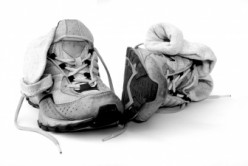How to Choose the Right Walking Shoe

When you're motivated to lose weight, the last thing you want are sore feet because you bought the wrong walking shoe. The right shoe can help prevent injuries, too.
Learn how to choose the right walking shoe with this expert advice.
The Basics of Walking Shoes
I’ve been following Wendy Bumgarnder’s expert advice on walking for years. She explains in simple terms the different types of walking shoes.And her advice to “Find a shoe fitting expert to help you discover the shoe that is best for your walking distance, speed, style, and surface, as well as your weight and stride” is spot on.
Read More: Walking Shoe Type and Tips
Walking Shoes: Features and Fit That Keep You Moving
The Mayo Clinic offers a comprehensive view of the different features of walking shoe. Learn the different parts of the shoe and why they’re important.You’ll also learn about arches and how to get the best fit whether your feet are neutral-arched, low-arched/flat feet or high-arched.
Read More: Mayo Clinic's What to Look For in A Walking Shoe
Walking Shoe Considerations & Fit
REI Co-op's advice adds in extra points to consider when choosing a walking shoe, including your walking style, shoe weight and waterproofing.They also recommend doing two tests before buying: walk down an incline and walk up a set of stairs.
Read More: Walking Shoes - How to Choose
A few more tips when shopping:
- Always try to find shoes that are shaped like your foot, and provide ample toe room. Tight shoes will cause blisters, calluses and many other problems with your feet that can make you feel miserable.
- Bring along the socks you’ll be wearing to walk and use these when trying on shoes.
- Have your feet sized before you buy your shoes. Changes occur to the feet as we get older, or even after having a baby. Sizes and shapes of the feet change, so you need to always check for proper measurements.
Replace Worn Out Shoes
Holding onto that pair of comfortable, worn-in pair of walking shoes will do you more harm than good.Shoes can lose their cushioning after three to six months of regular use, depending on how often and how far you walk. Even your weight can affect how quickly shoes need to be replaced.
Typically, they should be replaced every 300 to 500 miles, according to the American Academy of Podiatric Sports Medicine (AAPSM).
Check out the heel of your shoe for uneven wear patterns. If the heels are wearing down, or if the shoes are losing traction, it’s a good indicator that you need to replace your walking shoes.
One last tip: To save on the wear and tear, use your walking shoes only for exercise walking.
Once you find the perfect fit, you'll find it easier to incorporate walking as way to lose weight and get fit.
Related Articles
5 Ways to Burn More Calories Walking
12 Week Walking Program for Weight Loss
Benefits of Walking
